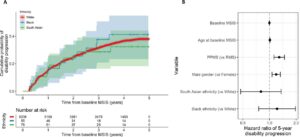
“Mouse model of multiple sclerosis induced by disrupting vesicular transport in oligodendrocytes.”
Chun Hin Chow, et al. – University of Toronto.
This study describes a new mouse model for studying MS, in which oligodendrocytes lose proteins critical for transporting myelin components, leading to demyelination. This produces symptoms similar to EAE and, unlike other targeted demyelination models, causes T cells to infiltrate the CNS and astrocytes to become reactive. The autoimmune response in this model may better reflect that seen in MS compared to EAE, which is caused by stimulating T cells to target myelin.
While this model may benefit studies of certain aspects of MS, there are drawbacks. The main obstacle is the crossing of two transgenic mouse lines. Beyond the increased breeding time needed to generate these mice compared to stock mouse lines, the use of a Cre line to delete genes from oligodendrocytes prevents cell type-specific manipulation of other cells. This would, for example, prevent the deletion of T cell components to investigate which are required for the demyelination process in this context. Nonetheless, being able to study neuroinflammation and autoimmunity in response to progressive demyelination, as opposed to artificially-induced T cell activation, will prove vital in understanding MS.




